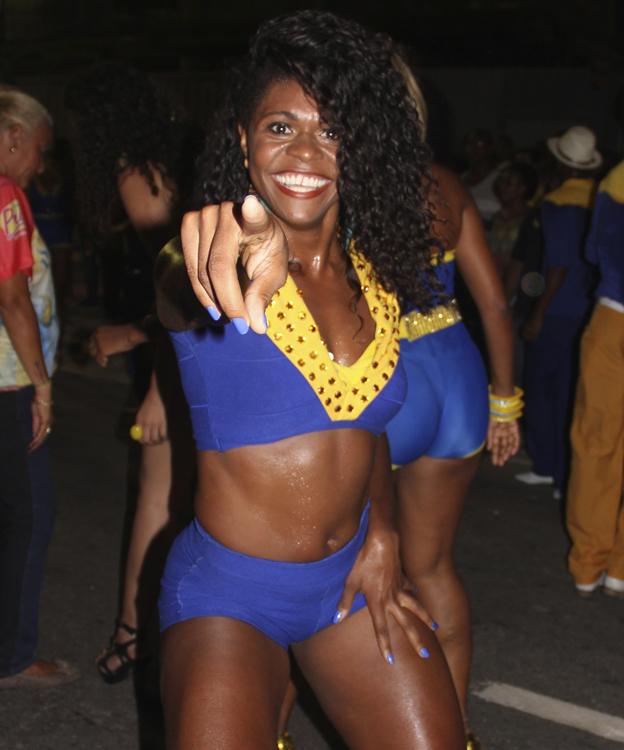Confessions of a British Carnival dancer
- Published

Friends laughed when Antonia Eklund, a fair-skinned British woman, said she would be auditioning for one of Rio's famous Afro-Brazilian samba schools. But she succeeded, and for the last three months has been shimmying and sweating - with some ups and downs - in preparation for this weekend's Carnival.
The archetypal samba dancer flounces a bounty of curves, from her cascading curls to her wide, barely-covered hips. I watched the girls in rehearsal as I waited for my audition with the Unidos da Tijuca samba school - the defending Carnival champions - and wondered what I was doing.
Few Europeans, or even white Brazilians, pass muster as passistas - as the samba dancers are called - and our attempts are usually stereotyped as a stiff shuffle.
There was one thing in my favour, though - at least I hoped there was.
The theme of Tijuca's show this year is Switzerland, in honour of renowned carnival designer Clovis Bornay, the son of a Swiss immigrant, whose young imagination was fed with stories of snowy mountains and strange European creatures.
I accepted that I couldn't bust out the same curves at the gym or tan-up in a few days before for the audition.
But I had noticed that not everything about the passistas' look was genetic. While a few maintained their natural hair - tight braids and short afros - many had extravagant weaves, known here as "mega hair" - so I impulsively fixed in some extensions to my own hair, shallowly thinking that the bigger it was, the greater my chances of success.

After an hour's wait, I was thrust into a 40-minute freestyle in Tijuca's public Saturday-night show. I was dressed up but not warmed up and it was knackering.
Another word for female samba dancers is mulata, meaning "mixed-race woman". The mulata is the counterpart of the trilby-tipping, quick-stepping malandro bad-boy, and shimmies around him in a playful, provocative manner.
Some girls challenged me to aggressive dance-offs and stripped the malandros away.
Afterwards, the director told me I was sambaing backwards rather than forwards - and I realised I had a long way to go. My mum helpfully pointed out that it should be obvious that samba moves forwards, given the great event is a 700m procession.
I scraped into a second-round audition, at which point one feisty but supportive passista told me I should upgrade my heels. The racing samba step is performed on tip-toe, so a higher platform shoe supports the ankle and actually helps you samba for longer. Never before had I thought of stripper heels as serious sports equipment.

I had to get some quickly, but you can't buy them in Copacabana, where I and most of my foreigner friends have settled. Unlike the cool, affluent Bossa Nova movement which went global in the 1950s straight from Rio's southern beachfront, the samba hub centres on poorer areas such as Madureira, further north.
Each samba school was established in a particular favela - an area of informal housing or shanty town - and they maintain strong community ties.
After a gruelling third audition, the director took me on, and I was living my dream. We rehearsed twice a week, sweating what seemed like half our body weight in huge community parties driven by the bateria drums.
In the changing rooms, I was enlightened to many new Portuguese terms that my language degree had passed over in silence - "adhesive bras", "blister tape" and, dare I say it, the "camel toe".
The girls called me nega or pretinha, words literally meaning black girl, but often used in the sense of "babe" or "honey". It made me laugh, but it was spontaneous and welcoming.

On Thursdays we rehearsed in the street as practice for the procession in the stadium. Among the potholes I learnt that some decent training is needed to get the best out of those heels.
One Thursday I fell and sprained my ankle. I had to use an immobilising boot for three weeks and got plenty of practice with phrases such as "ice-packs", "anti-inflammatories", "physiotherapy" and, worst of all, "total inactivity".
If you say in Portuguese that you "fell in samba", it gives the idea of fully letting go - losing all inhibitions in the dance. For many Brazilians, I had - hilariously - turned the popular phrase into a literal misfortune.

Some, however, took the misfortune more seriously and told me I had underestimated the religious side of samba. So, unsure but curious, I was taken to a healer of the Afro-Brazilian religion, Umbanda.
Heavy rain on the tin roof competed with guttural convulsions and cries of "Maria", as chosen mediators received the spirits. I sat in a back room with an old lady in white who leant forward on widely parted knees, smoking a wooden pipe. The vovo, I was told, lends her body to the spirits to converse with believers.
On a shelf behind her stood figurines of saints and Latin American Orixa deities. Under colonial rule, African slaves assigned Catholic images to their own deities, using them as masks to secretly continue their own traditional worship. Similarities were found between the Catholic Saint George and the Yoruba god of war, Ogum, for example, and the traditions began to fuse.
The vovo told me I had been injured by harmful energies born of territorial resentment. This olho-grande or "big-eye", she explained, is different from voodoo, when a stronger charm is ceremoniously prepared. To become a real passista, she said, I had to look after my spiritual guardians, and they would protect me.
Credit to the spirits or to my physiotherapist, that week I was dancing again - with just two weeks to regain my fitness for the parade.

Carnival is an important event in the Christian calendar - the last blow-out before Lent - but many of the samba schools were established by Umbanda priests, and some drumming riffs invoke the African deities that are often depicted in the floats. So it's a vibrant manifestation of Brazil's post-colonial melting-pot culture.
Tijuca, in particular, continues to push this forward, celebrating the presence of immigrant communities such as the Swiss.
Many thought that I was Swiss and had been imported as part of the theme. Either way, I was fortunate to be given a role in this cultural mix and with any luck will be samba-ing forward rather than backwards on Monday.
Subscribe to the BBC News Magazine's email newsletter to get articles sent to your inbox.